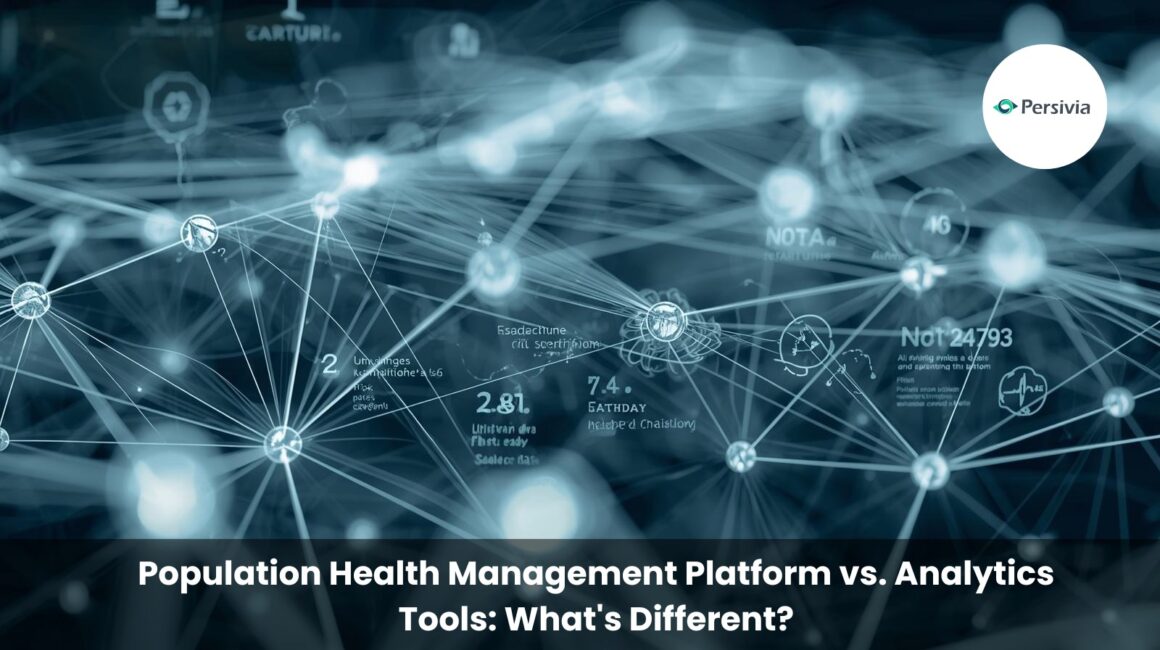A Population Health Management Platform unifies data, automates workflows, and manages care at scale. Analytics tools do not implement the care plans or intervene in managing the data; they just analyse it. Platforms provide actionable programs in AI-based risk stratification, care gaps, and patient engagement capabilities. The analytics tools will only give insight and need implementations in individual systems. Healthcare organizations require end-to-end population health management platforms, not data visualization.
When it comes to raising patient outcomes and reducing costs, healthcare organizations are faced with a very serious choice to make. Many end up spending on analytics tools with high expectations of full population health solutions, only to discover that they have bought a reporting system with no execution features. The overlap of population health management tools and standalone analytics introduces gaps in care delivery, missing quality measures, and frustrated care teams across disconnected systems.
It is not only a technical difference but a functional difference. A Population Health Management Platform integrates data, AI-based programs, risk stratification, care management processes, and patient interaction into a single platform. Data analytics visualizes data, but does not take action. This distinction will help healthcare leaders select solutions that convert data to better health instead of pretty dashboards.
What is a Population Health Management Platform?
A Population Health Management Platform is an IT platform that consolidates patient data through various sources, determines at-risk groups, automates treatment measures, and evaluates outcomes at the patient population level.
These platforms generate a longitudinal patient record by aggregating data in EHRs, practice management systems, labs, claims, pharmacy systems, and Health Information Exchanges. The system then uses AI to detect lapses in care, tier risk levels, use AI to develop care plans, and notify care teams about patients who need attention.
Core functions include:
- Data aggregation from multiple sources into unified patient records
- AI-driven risk stratification identifies modifiable health risks
- Automated eligibility determination for care programs
- Evidence-based care pathways with built-in clinical protocols
- Workflow integration for care managers and providers
- Patient engagement through phone, SMS, and telehealth
- Quality measure tracking and value-based care reporting
The platform oversees the entire process finding the patients that require intervention, through to implementing that intervention and the outcome measures.
What Are Analytics Tools in Healthcare?
Healthcare analytics software works with the data to create reports, visualizations, and insights regarding patient populations and operational performance.
Such tools are linked to data sources and generate dashboard displays illustrating utilization patterns, costs, readmission rates, and quality measure performance. They are useful in assisting the organization to know what is going on, without care management functionality or patient intervention capabilities.
Typical analytics features:
- Data visualization through charts and graphs
- Custom reporting on clinical and financial metrics
- Trend analysis for utilization and costs
- Benchmark comparisons across facilities or providers
- Ad-hoc query capabilities for specific data questions
Analytics tools provide answers to questions such as what happened and why it happened, but they need to support other systems to answer the question of what we should do about it.
Key Differences Between Platforms and Analytics Tools
Data Integration vs. Data Analysis
Population Health Management Platform: Collects data from many sources, such as various EHRs, claims systems, labs, and HIEs. This data is standardized and normalized into a single longitudinal patient record, which is updated in real-time via the platform.
Analytics Tools: Connect to existing data warehouses or limited data sources. They analyze whatever data is available, but don’t create comprehensive patient records across disparate systems.
Note:
The difference in integration is important because care teams require a full patient history, not individual systems’ partial views of the patient. The scale of a platform that provides management of millions of patient records and supports multiple EMR systems offers insights that can only be matched by single-source analytics.
Execution vs. Observation
Population Health Management Platform: Population Health Management Platform: Automated care interventions. Upon the system detecting a patient with diabetes who has not had an HbA1c test, it creates a care plan, assigns care managers, initiates patient outreach, and monitors compliance.
Analytics Tools: Identify the same gap, but generate only a report. Someone must manually create the intervention, assign responsibility, and track follow-up using separate systems.
Note:
This execution gap creates delays between insight and action. In platforms, population health management analytics instantly transforms findings into care team workflows, whereas standalone analytics necessitate data to be manually translated into operational steps.
AI-Powered Programs vs. Static Reports
Population Health Management Platform: Rolls out many AI-based applications to meet the demands of particular conditions and populations. All programs are automated to screen eligibility, compute risk adjustments, generate care plans, issue clinical alerts, and evaluate.
Programs also consist of inherent evidence-based pathways that respond to patient responses. This AI constantly improves risk stratification as new data comes in, providing interventions to the right patients at the right time.
Analytics Tools: Produce scheduled or ad-hoc reports based on predefined queries. Users must interpret findings and manually design interventions. No automated programs adjust care strategies based on population changes.
Care Management Workflow vs. Dashboard Access
Population Health Management Platform: Integrates directly into clinical workflows. Care managers log in to access prioritized patient lists with risk scores, pending tasks, care gaps that need to be closed, and suggested interventions. The system records all activities, assists with billing care management services, and offers telehealth functionality.
Analytics Tools: Require users to toggle between the analytics system and their EHR or care management platform. No native workflow support means data insights stay disconnected from daily care delivery operations.
Patient Engagement vs. Reporting
Population Health Management Platform: Allows outreach to patients via phone and SMS messages, and video calls. The system monitors communication efforts, records patient responses, and modifies care plans as engagement levels change.
Analytics Tools: Identify which patients need engagement but provide no communication capabilities. Organizations need separate patient engagement platforms to act on analytics findings.
Value-Based Care Management vs. Performance Measurement
Population Health Management Platform: Manages multiple value-based contracts simultaneously. The system tracks performance across different payers, calculates quality measure achievement, monitors shared savings opportunities, and generates submission-ready reports for various programs.
Analytics Tools: Measure performance against value-based metrics, but don’t manage contract requirements, calculate risk adjustment factors, or support multi-payer program tracking in an integrated way.
When Healthcare Organizations Need a Full Platform
Companies that are members of ACOs, Medicare Shared Savings Programs, or other commercial value-based programs require platforms that can: track patient attribution, measure metrics unique to the contract, and coordinate care across various program demands.
Simple analytics will not be able to handle the complexity of multiple attribution lists, different quality measures, and different reporting schedules across payers.
Closing Care Gaps at Scale
Identifying thousands of patients with overdue preventive screenings requires one thing. Actually getting those patients scheduled, completing the services, and documenting everything for quality reporting requires entirely different capabilities.
Platforms automate gap closure workflows that analytics tools merely identify. The difference shows in HEDIS and STAR ratings, where execution matters more than awareness.
Transitioning to Risk-Based Payments
Risk adjustment requires accurate diagnosis capture, proper documentation, and submission of encounter data. A digital health platform with integrated risk adjustment functionality automates HCC coding suggestions, tracks suspected conditions requiring validation, and ensures compliant documentation.
Analytics might show risk adjustment factor calculations, but platforms manage the operational processes driving revenue capture.
Coordinating Complex Care Management
Patients with behavioral health needs, social determinants, and multiple chronic conditions need multidisciplinary efforts by various team members. Platforms offer collective care plans, task assignments, communication records, and outcome tracking within the whole care team.
Analytics tools show which patients have complex needs, but don’t facilitate the coordination required to address them.
What Analytics Tools Do Well
Analytics tools excel at specific use cases where observation and measurement matter more than execution.
- Population health stratification: Analyzing large datasets to identify high-risk cohorts and utilization patterns across populations.
- Financial analysis: Understanding cost drivers, comparing facility performance, identifying leakage to out-of-network providers, and forecasting budget impacts.
- Research and strategic planning: Exploring historical trends, testing hypotheses about care delivery models, and evaluating program effectiveness over time.
- Executive reporting: Providing leadership with performance dashboards tracking key organizational metrics.
Organizations with robust operational systems already in place might add analytics tools for deeper insights without needing a full platform replacement.
The Cost of Choosing Wrong
Analytics Without Execution Creates Frustration
Care teams become frustrated when systems show problems without enabling solutions. A report listing 1,000 patients with care gaps helps no one if staff must manually call each patient using separate systems.
Multiple Point Solutions Increase Complexity
Buying analytics, then adding separate care management software, risk stratification tools, and patient engagement platforms, creates integration nightmares. Data flows break between systems, workflows fragment across applications, and the total cost of ownership exceeds integrated platform pricing.
Delayed Implementation Costs Lives and Money
The months required to integrate multiple point solutions delay program launches. Every quarter without effective population health management means missed quality bonuses, higher acute care costs, and patients progressing to more serious conditions.
Platform Selection Criteria
| Capability | Population Health Platform | Analytics Tool |
| Data Integration | Multiple EMRs, claims, labs, HIEs | Limited sources require a data warehouse |
| Longitudinal Patient Record | Complete unified record | Depends on source data availability |
| AI-Powered Programs | Many automated programs | No manual program design needed |
| Care Management Workflows | Built-in task management and documentation | No workflow capabilities |
| Patient Engagement | Phone, SMS, and telehealth integrated | Requires a separate engagement platform |
| Risk Stratification | Automated, continuous, AI-driven | Static reports requiring manual interpretation |
| Value-Based Contract Management | Multi-payer tracking and reporting | Performance measurement only |
| Implementation Complexity | Single platform deployment | Multiple system integrations required |
How Platforms Adapt as Healthcare Evolves
Healthcare data sources constantly change. New EHR versions are released, payers modify data feeds, and organizations merge systems during acquisitions.
Population Health Management Platform architectures adapt seamlessly to these changes. When a data source evolves, the platform’s integration layer adjusts without disrupting workflows, analytics, or reporting. Care teams continue working normally while technical teams handle backend updates.
Analytics tools often require reconfiguration, new queries, and workflow adjustments when source systems change. The fragility creates operational risk during transitions.
Making the Right Investment
Healthcare organizations should assess their operational maturity before choosing between platforms and analytics tools.
Choose a platform when:
- Managing risk-based contracts requiring active intervention
- Coordinating care across fragmented delivery systems
- Closing quality gaps at scale across large populations
- Needing integrated workflow support for care teams
- Tracking outcomes across multiple value-based programs
Consider analytics tools when:
- Existing operational systems handle care management effectively
- The primary need is executive reporting and strategic analysis
- Resources exist to integrate and maintain multiple point solutions
- Focus is on measurement rather than intervention
Most organizations pursuing value-based care success need platforms delivering comprehensive population health management tools rather than analytics in isolation.
Wrap UP
Analytics tools inform decisions, but Population Health Management Platforms enable action. Platforms integrate data, automate interventions, and drive measurable results in value-based care.
More than 100 million patient records are managed through Persivia offers a unified platform, CareSpace®, trusted for complete population health management. With seamless integration across 70+ EMR systems, 20+ health plans, and multiple Health Information Exchanges, Persivia’s AI-driven tools automate risk stratification, care coordination, and patient engagement. Replace fragmented analytics with a solution designed for real-world clinical and operational impact.

